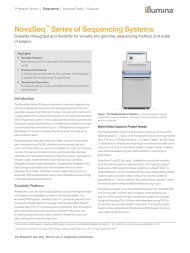Abstracts
ngsfinalprogram
ngsfinalprogram
You also want an ePaper? Increase the reach of your titles
YUMPU automatically turns print PDFs into web optimized ePapers that Google loves.
Oral Presentation <strong>Abstracts</strong><br />
laboratories in the states and internationally to<br />
build applications to extract information about<br />
genus, species, lineage, serotype, pathotype,<br />
virulence profile and antimicrobial resistance<br />
markers and subtyping using gene by gene approaches<br />
(whole genome multi-locus sequence<br />
typing, wgMLST) from the genome sequences.<br />
The PulseNet foodborne disease surveillance<br />
network infrastructure and analytical platform<br />
(BioNumerics, Applied Maths) and database<br />
will be used because of its versatility and<br />
because the public health laboratories have<br />
worked with it for > 15 years. Additionally,<br />
the use of this analytic software does not require<br />
extensive bioinformatics skills or local<br />
high performance computing capacity. The<br />
method will also be validated and will replace<br />
conventional CLIA related reference identification<br />
activities in the branch and public health<br />
laboratories. Results: WGS has successfully<br />
been tested for the US national surveillance<br />
of listeriosis since September 2013 and the<br />
wgMLST analysis has been implemented in<br />
the daily routine. The technology has proven<br />
its power supplementing traditional methods in<br />
outbreak investigations by adding phylogenetic<br />
relevance and increased resolution compared<br />
with current methods thereby enhancing case<br />
definitions and source tracking. The wgMLST<br />
method is currently being piloted in-house<br />
for surveillance of Campylobacteraceae,<br />
Shiga toxin-producing E. coli, and Salmonella<br />
with the remainder of foodborne bacteria to<br />
be added over the next three years. A betatesting<br />
pilot with the PulseNet public health<br />
laboratory partners will start in summer 2015.<br />
Conclusion: WGS will revolutionize the surveillance<br />
of both sporadic and outbreak related<br />
foodborne infections by replacing and enhancing<br />
current laboratory methods in use in public<br />
health laboratories.<br />
n S4:4<br />
SALMONELLA SEROTYPE DETERMINATION<br />
UTILIZING HIGH-THROUGHPUT GENOME<br />
SEQUENCING DATA<br />
S. Zhang 1 , Y. Yin 2 , M. Jones 3 , Z. Zhang 4 , B.<br />
Deatherage Kaiser 5 , B. Dinsmore 6 , C. Fitzgerald<br />
6 , P. Fields 6 , X. Deng 1 ;<br />
1<br />
University of Georgia, Griffin, GA, 2 Illinois<br />
Institute of Technology, Chicago, IL, 3 J. Craig<br />
Venter Institute, Rockville, MD, 4 University of<br />
Michigan, Ann Arbor, MI, 5 Pacific Northwest<br />
National Laboratory, Richard, WA, 6 Centers<br />
for Disease Control and Prevention, Atlanta,<br />
GA.<br />
Serotyping forms the basis of national and<br />
international surveillance networks for Salmonella,<br />
one of the most prevalent foodborne<br />
pathogens worldwide. Public health microbiology<br />
is currently being transformed by whole<br />
genome sequencing (WGS) which opens the<br />
door to serotype determination using WGS<br />
data. SeqSero (www.denglab.info/SeqSero)<br />
is a novel web-based tool for determining<br />
Salmonella serotypes using high-throughput<br />
genome sequencing data. SeqSero is based<br />
on curated databases of Salmonella serotype<br />
determinants (rfb gene cluster, fliC and fljB<br />
alleles) and is predicted to determine serotype<br />
rapidly and accurately for nearly the full spectrum<br />
of Salmonella serotypes (more than 2,300<br />
serotypes), from both raw sequencing reads<br />
and genome assemblies. The performance of<br />
SeqSero was evaluated by testing: 1) raw reads<br />
from genomes of 308 Salmonella isolates of<br />
known serotype; 2) raw reads from genomes<br />
of 3,306 Salmonella isolates sequenced and<br />
made publicly available by GenomeTrakr, a<br />
U.S. national monitoring network operated<br />
by the Food and Drug Administration; and 3)<br />
354 other publicly available draft or complete<br />
Salmonella genomes. We also demonstrated<br />
Salmonella serotype determination from raw<br />
sequencing reads of fecal metagenomes from<br />
mice orally infected with this pathogen. Seq-<br />
Sero can help to maintain the well-established<br />
ASM Conference on Rapid Next-Generation Sequencing and Bioinformatic<br />
Pipelines for Enhanced Molecular Epidemiologic Investigation of Pathogens<br />
21



